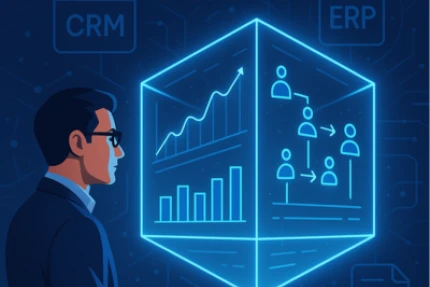
As 2024 approaches, SaaS CFOs face the challenging task of managing both growth expectations with operational efficiency. While optimism about improving market conditions abounds, the days of pursuing “growth at all costs” are fading into memory. It’s now all about efficient growth.
Performance Trends and Themes in 2023
Uncertain market conditions in 2023 had varying impacts on top-line growth across the SaaS industry. Companies catering to larger enterprises performed better compared to those targeting small and medium-sized businesses (SMBs). Industry-specific factors played a crucial role in determining growth. For instance, companies serving sectors less affected by economic fluctuations, such as defense, cybersecurity, and transportation, fared better and maintained consistent growth last year. Market conditions also impacted the sales process, causing elongated sales cycles and a heightened need for internal approvals. Nevertheless, SaaS companies displayed resilience by adapting their strategies to preserve profit margins and drive growth in 2023.
ICP & Industry Verticals
High churn rates in smaller customer segments prompted many companies to move upmarket and redefine their Ideal Customer Profile (ICP) to focus on larger enterprises. This strategic move made it easier to counterbalance the impact of churn among smaller customers with expansion in larger accounts.
Pricing Models
In 2023, several companies adjusted their pricing models to enhance or maintain their top-line performance. Given the market’s uncertainties, budget-conscious customers made selling SaaS products more challenging. As a response, some companies shifted from time-based pricing to usage-based pricing, providing flexible options to risk-averse customers. However, companies catering to functions heavily impacted by layoffs found that seat-based pricing models were ineffective in driving growth in 2023.
Unprofitable SaaS companies felt a heightened urgency to cut back spending in 2023. As a result, many conducted assessments to identify areas where cost reductions would minimally impact growth. This approach involved strategic reduction in marketing and advertising spending, which successfully reduced cash burn for many.
Strategies for Sustainable, Efficient Growth in 2024
Incorporating factors such as remote work and GenAI, companies have found new avenues to “do more with less.” Despite optimism about improved market conditions in 2024, CFOs remain cautious about setting high growth targets.
“We’re going through our Series B raise right now and I initially had a plan that was really aggressive on top line growth. One of our Series A lead investors actually asked me to temper the top line down and balance that with getting to profitability earlier.”
Sales and Marketing
While most CFOs expect to invest more in sales and marketing in the upcoming year, they are taking precautions to ensure these investments do not negatively OpEx margin in 2024.
Cash-In Commission Plans
In 2023, cash flow was closely monitored by most SaaS businesses. Some realized that their sales commission plans, which were not linked to when customers made payments, had a substantial impact on cash flow. Looking ahead to the upcoming year, many are now tying commissions to invoice payment timelines in 2024. Now, Account Executives (AEs) will be incentivized to ensure prompt and on-time payments.
Offshore Hiring
The shift to remote work during and after COVID has led many seasoned inside sales reps to move abroad. As such, there is now an opportunity for companies to find cost-effective, English-speaking sales and marketing talent in countries like Spain.
Focus on Rep Efficiency
In recent years, some CFOs reduced quotas in an effort to fuel a healthy culture and not discourage new sales reps. However, with market conditions expected to bounce back, CFOs want to see a clear ROI for new and existing sales hires. Firstly, CFOs are increasing 2024 quotas and carefully managing Quota to OTE ratios in order to improve CAC Payback.
Additionally, many are keen to find the golden number of AEs that maximizes efficiency. As such, many CFOs plan to closely monitor Bookings per Ramped Rep as new AEs onboard in the coming year. Some CFOs have also noted higher quota attainment expectations, holding reps much more accountable for reaching at least 80% quota attainment.
Flexible Hiring and Compensation
For companies focused on profitability, uncertain top-line growth and sales assumptions can significantly impact cash burn. To mitigate this risk, many CFOs are introducing flexibility into their operating models. This flexibility includes hiring and compensation adjustments tied to the attainment of top-line growth targets. While this approach complicates planning for managers, it effectively manages company risk and minimizes the potential for layoffs, while also serving as a path toward profitability. This strategy has been well received by investors and board members.
COGS
Many CFOs have noted that a large part of the efficient growth balancing act will be to manage critical investments in COGS expenses while minimizing the negative impact on Gross Margin.
Customer Expansion & Retention
In 2023, not all SaaS businesses were ready to capitalize on the vast expansion potential of their existing customer base. For 2024, many CFOs are revising their plans to account for higher expansion targets. As such, while many expect to grow their customer success and renewals teams, they also want to see NRR significantly increase. Therefore, CFOs plan to set clear NRR targets for the business, and some CFOs will even compensate customer success teams on individual NRR performance.
On the other hand, companies with overstaffed customer success teams in 2023 plan to keep headcount the same in 2024 and stretch the responsibilities of existing account managers.
Implementation Optimization
While CFOs expect to see significant customer growth in the upcoming year, many do not anticipate increasing implementation team headcount. To improve Gross Margin, many CFOs are exploring alternative measures that can reduce the burden of growth on individual implementation managers. For example, many are investing more heavily in R&D strategies such as AI to automate all or some aspects of the implementation process.
“Over the last three years, implementations have been hampering our margins. In 2024, we want to figure out how we can shorten the implementation timelines so we can grow our customer base without having to add headcount. As such, we are looking to our product teams to make our implementation experience friendlier.”
R&D
Across the board, CFOs plan to invest in R&D. While some are investing to finally address tech debt, others realize they need to invest in new functionality simply to remain competitive. Nevertheless, the need for more engineers is clear. However, many CFOs noted that ROI on R&D investments is not always immediately clear. As a result, many are struggling with how to justify these investments on paper. In turn, many are considering options for more efficient R&D investments.
In recent years, as developers have churned, many CFOs found OpEx efficiency in backfilling the roles with offshore alternatives. This will be an important strategy for CFOs looking to grow their engineering teams in the upcoming year.
Conclusion
SaaS financial leaders plan to navigate evolving market dynamics and the pursuit of sustainable growth in 2024 with agility and strategic precision. The road to profitability and expansion in 2024 is marked by prudent considerations and a commitment to achieving the ideal balance between growth expectations and operational efficiency. While new investments will be made across the business, CFOs in 2024 will want to see a tangible ROI and shorter CAC Payback Period in turn.



